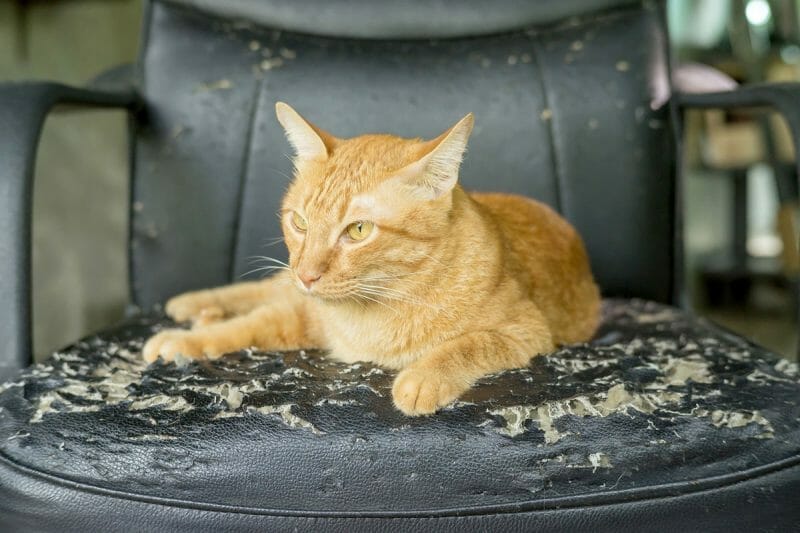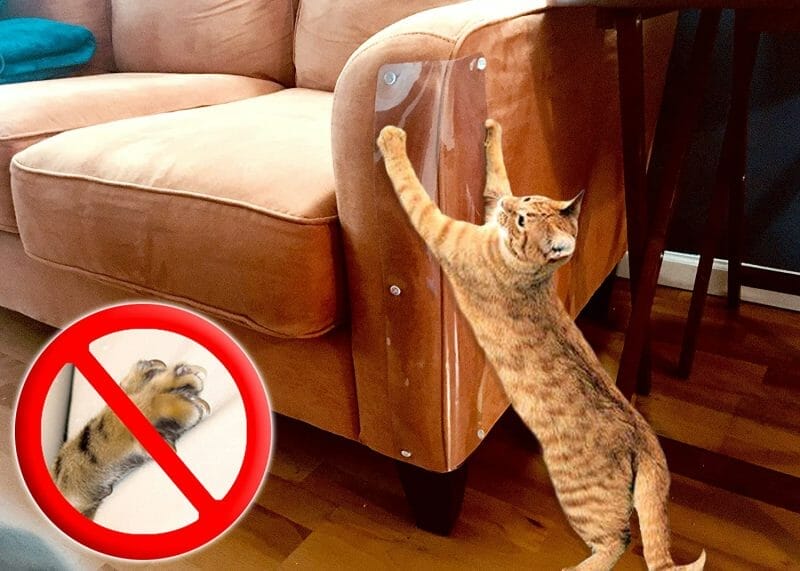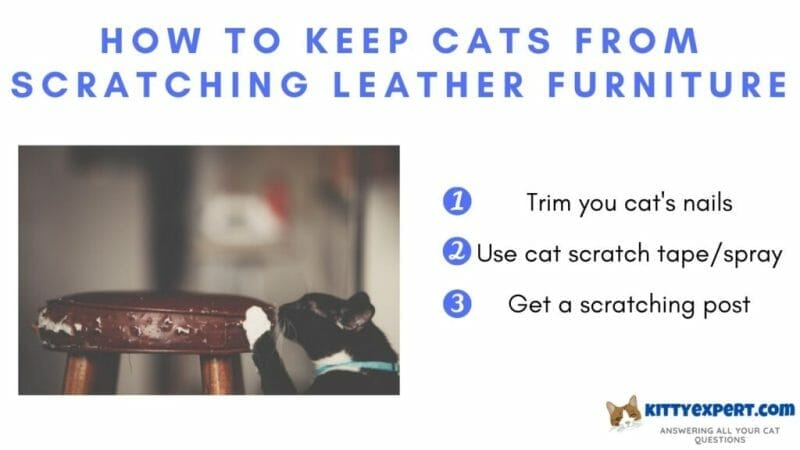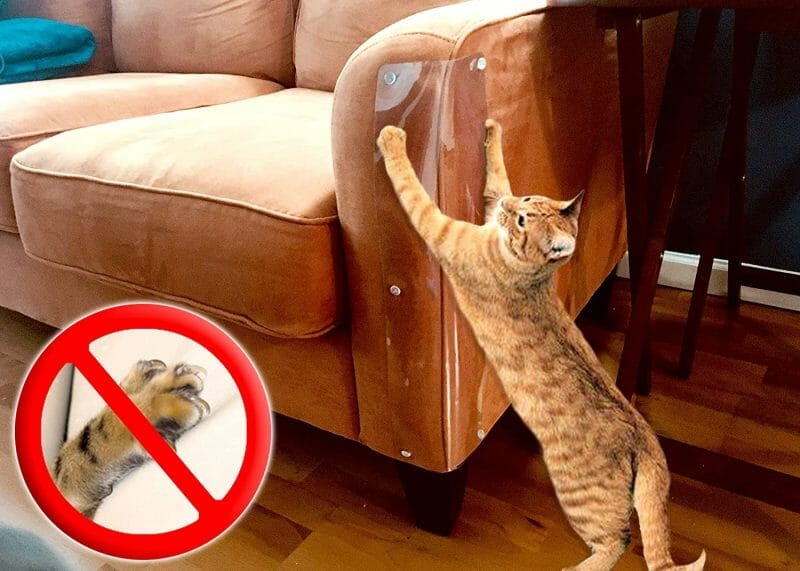Are you tired of your beloved furry friend scratching up your beautiful leather furniture?
Don’t worry, we’ve got you covered! Keeping a cat from scratching leather furniture can be challenging, but with the right techniques and strategies, you can protect your furniture and keep your cat happy too.
Firstly, make sure to provide your cat with plenty of appropriate scratching surfaces such as cat trees, scratching posts, and cardboard scratchers. By offering alternatives, you can redirect their natural scratching instincts away from your leather furniture. Another effective method is to use deterrents like double-sided tape or aluminum foil on your furniture. Cats dislike the sticky or crinkly texture, making them less likely to scratch. Additionally, you can try using a cat-friendly deterrent spray that has a scent cats find unappealing. Regular nail trims are also crucial in preventing your cat from causing damage. By keeping their nails short and blunt, you minimize the potential for scratching accidents. Remember to reward your cat with treats and praise during the trimming process to make it a positive experience for them. Lastly, providing mental and physical stimulation through interactive playtime and enriching toys will help redirect your cat's energy and prevent them from resorting to destructive behaviors like scratching furniture. Engaging with your cat in these activities will not only keep them entertained but also strengthen the bond between you.
Now that you know what to do, let’s unveil the details so that you can implement these tips to solve the issue.

Providing Appropriate Scratching Alternatives
Scratching is a natural behavior for cats, as it helps them stretch their muscles, sharpen their claws, and mark their territory. However, it can become a problem when cats start scratching furniture, curtains, or other household items. To prevent this destructive behavior, it’s essential to provide appropriate scratching alternatives for your feline friend.
1. Scratching Posts:
One of the most effective ways to redirect your cat’s scratching behavior is by providing a scratching post.
Scratching posts come in various shapes, sizes, and materials, so you can choose one that suits your cat’s preferences.
Look for posts made of sisal rope, corrugated cardboard, or carpeting as these textures are known to attract cats.
2. Scratching Pads:
If your cat prefers a horizontal surface to scratch on, consider getting a scratching pad. These flat pads are usually made of sisal, cardboard, or carpet and can be placed on the floor or attached to a wall.
Some scratching pads even come with catnip or interactive toys to further entice your cat.
3. Scratching Towers:
For households with multiple cats or cats that enjoy climbing, a scratching tower can be a great option.
These tall structures often feature multiple levels, platforms, and scratching surfaces. Cats can climb, play, and scratch to their heart’s content, reducing the likelihood of them resorting to furniture scratching.

4. Cat Trees:
If you have a cat that loves to climb and explore, a cat tree can be a fantastic scratching alternative.
Cat trees are multi-level structures that offer various platforms, hiding spots, and scratching posts.
By providing a cat tree, you give your feline companion a designated space for scratching and playing, keeping them away from your furniture.
5. Deterrent Sprays:
In addition to providing appropriate scratching alternatives, you can use deterrent sprays to discourage your cat from scratching furniture.
These sprays usually have a scent that cats find unpleasant, such as citrus or bitter apple. By applying the spray to the items you want to protect, you can help redirect your cat’s scratching behavior.
6. Positive Reinforcement:
When introducing your cat to a new scratching alternative, it’s important to use positive reinforcement.
Encourage your cat to explore the scratching post, pad, tower, or tree by placing treats or toys nearby. Praise and reward your cat whenever they use the designated scratching area, reinforcing the idea that it is a desirable behavior.
Remember, it may take time for your cat to adjust to the new scratching alternatives, especially if they have been accustomed to scratching furniture. Be patient and persistent in redirecting their behavior, and avoid punishing your cat for scratching inappropriately. With a little time and effort, you can successfully provide your cat with appropriate scratching alternatives and protect your furniture.

Seeking Professional Help for Persistent Scratching Behavior
If your cat is constantly scratching itself, it may be more than just a minor annoyance. Persistent scratching behavior can be a sign of an underlying issue that requires professional attention. In this section, we will discuss the importance of seeking professional help for persistent scratching behavior in cats.
1. Identifying the Cause
The first step in addressing persistent scratching behavior is identifying the cause. While occasional scratching is normal for cats, excessive or constant scratching can indicate a variety of problems. It could be due to allergies, parasites, skin infections, or even behavioral issues.
A professional veterinarian is trained to examine your cat and determine the root cause of the scratching behavior. They will conduct a thorough physical examination, ask about your cat’s medical history, and may even run additional tests or take samples for analysis.
2. Tailored Treatment Plan
Once the underlying cause of the scratching behavior is identified, a professional can develop a tailored treatment plan for your cat. This may include medication, dietary changes, environmental modifications, or behavior modification techniques.
For example, if your cat is scratching due to allergies, a veterinarian may prescribe antihistamines or recommend hypoallergenic diets. If parasites are the culprit, appropriate medications will be prescribed to eliminate the infestation. In cases of behavioral issues, a professional may suggest environmental enrichment or training techniques to redirect your cat’s scratching behavior.
3. Preventing Complications
Seeking professional help for persistent scratching behavior can help prevent further complications. Continuous scratching can lead to skin lesions, infections, and discomfort for your cat. By addressing the issue promptly, a veterinarian can provide the necessary treatment to alleviate your cat’s discomfort and prevent secondary complications.
Additionally, professional guidance ensures that the treatment plan is safe and effective for your cat. Over-the-counter remedies or home remedies may not always be suitable for your pet and could potentially worsen the condition or cause adverse reactions.
4. Expert Advice and Support
When it comes to your pet’s health, there is no substitute for expert advice and support. Veterinarians have extensive knowledge and experience in diagnosing and treating various conditions in cats, including persistent scratching behavior.
They can provide valuable guidance on how to manage the scratching behavior, offer recommendations for products or treatments, and answer any questions or concerns you may have. Their expertise can help you navigate through the process of addressing your cat’s scratching behavior effectively.
5. Monitoring and Follow-up
After implementing the treatment plan, it is important to monitor your cat’s progress and follow up with the professional as recommended. They will assess the effectiveness of the treatment and make adjustments if necessary.
Regular check-ups and communication with a professional ensure that your cat’s scratching behavior is properly managed and any underlying issues are resolved. It also provides an opportunity to address any new concerns that may arise during the course of treatment.
1. How can I keep my cat from scratching my leather furniture?
To prevent your cat from scratching your leather furniture, provide them with appropriate scratching alternatives like a scratching post or pad. Apply double-sided tape or a cat repellent spray to the furniture to deter them. Trim your cat’s nails regularly and consider using soft nail caps. Lastly, provide plenty of toys and playtime to keep your cat mentally and physically stimulated.
2. What are some cat-friendly alternatives to leather furniture?
If you want to avoid leather furniture altogether, consider opting for materials like microfiber or synthetic fabrics, which are less appealing for cats to scratch. Alternatively, you can choose furniture with removable and washable covers, so you can easily remove any signs of scratching or wear.
3. Should I punish my cat for scratching my leather furniture?
No, it is not recommended to punish your cat for scratching your leather furniture. Punishment can create fear and anxiety in your cat, potentially leading to other behavior problems. Instead, focus on providing appropriate scratching alternatives and using deterrents to redirect their behavior.
Conclusion
It is essential to protect your leather furniture from your cat’s scratching habits. By implementing a few simple strategies, you can keep your furniture safe and your cat happy.
Firstly, provide your feline friend with a designated scratching post or board to redirect their natural instinct.
Secondly, consider using deterrents such as double-sided tape or pet-friendly anti-scratch sprays to discourage your cat from targeting the leather furniture.
Additionally, regular nail trimming and providing ample playtime and enrichment can help curb your cat’s destructive behavior.
Remember, consistency and patience are key when training your cat to avoid scratching your leather furniture.


